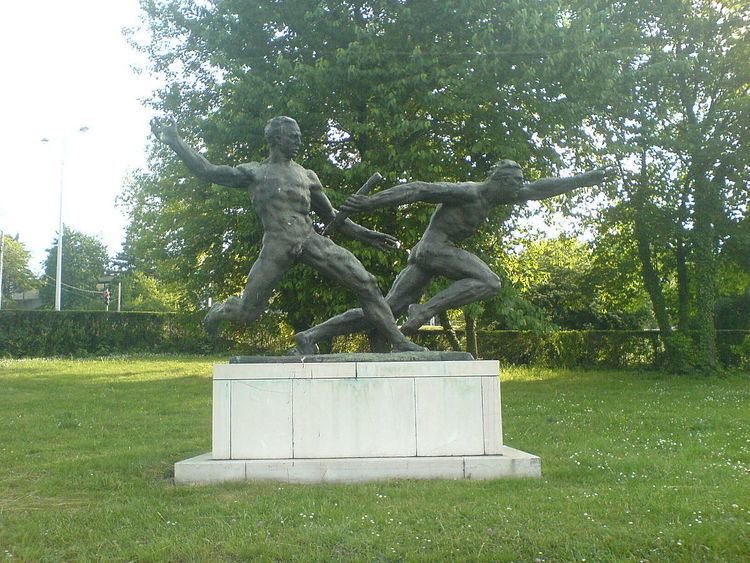Full name Partizan Stadium Opened 9 October 1949 Phone +381 61 7411133 | Architect Mihailo Janković | |
 | ||
Former names JNA Stadium (1951–1989) Address Humska 1, Beograd 11000, Serbia Similar Rajko Mitić Stadium, Omladinski stadion, Karađorđe Stadium, King Peter I Stadium, Church of Saint Sava | ||
The Partizan Stadium (Serbian: Стадион Партизанa / Stadion Partizana) is a football and track-and-field stadium in Autokomanda, municipality of Savski Venac, Belgrade, Serbia, which has a seating capacity of 32,710. Situated on the Topčider Hill, at Humska 1 street it is a home field of Partizan Belgrade. Also, it was the home of Partizan's main rival Red Star Belgrade from 1959 to 1963, when they moved to the Marakana Stadium.
Contents
It carried the name JNA Stadium (Serbian: Стадион ЈНА (Стадион Југословенске народне армије) / Stadion JNA (Stadion Jugoslovenske narodne armije)) for a long time and was the site of Youth Day parade. Even today, the majority of football fans in all countries of the former SFR Yugoslavia call it by its old name. Partizan fans, the Grobari, call it also Fudbalski hram (English: The Temple of Football). The stadium has four stands: the south, north, west and east. Before conversion to an all-seater stadium, the ground had a capacity of 50,000 people.
There were plans to replace the current stadium with a new one. Swiss companies Mob Lab and Marazzi-Paul presented a project of a 38,000 seated stadium with commercial contents. The construction was supposed to start in 2006 but it was postponed and later cancelled.
History
Construction of the stadium was started after World War II, on the site of BSK Stadion, which was a 25,000 seat stadium that hosted the Yugoslav national team as well as BSK Beograd. The stadium was built with the help of the Yugoslav People's Army, in the period between 1948 and 1951. Although the stadium was not completely finished, the first match was Yugoslavia against France on 9 October 1949, which ended 1–1. The ground was officially opened on Yugoslav People's Army Day, on 22 December 1951.
From 1957 to 1987 the stadium was the site of Youth Day parade. Every year on 25 May the Relay of Youth were held in Socialist Federal Republic of Yugoslavia. Participants carried a baton with a birthday message to President Josip Broz Tito. The Relay of Youth was a symbolic relay race which started in Tito's birth town Kumrovec and went through all major towns and cities of the country and it ended in Belgrade at JNA Stadium. On 1 April 1957, the stadium received its first electronic scoreboard. First time it was used on a match between Partizan and Vardar Skoplje on 30 November 1957.
The stadium was a site of the 7th European Athletics Championship which was held from 12 to 16 September 1962.
In April 1989, Partizan Belgrade purchased the stadium from the former Yugoslav People's Army, and thus became the owner. The name of the stadium were officially changed in Partizan Stadium. Partizan stadium had a 50,000 capacity before the new UEFA security regulations came in effect. There were 15 924 seats, 33 000 standing places and 585 box seats. It was renovated in 1998, and has had a capacity of 32,710 since.
On September 2010, Partizan stadium was reorganized in a few places for the UEFA Champions League. Due to UEFA stadium standards, the fences on the eastern and western stands were shortened from 2.25m to 0.70m. The football pitch was extended by 1 square meter. New, modern goal-posts were mounted, and brand new media boxes were constructed on top of the western stand. Partizan's Champions League game against Arsenal on 20 September, was almost postponed due to two of the stadium's floodlights failing. However one of them was fixed and the referee, Wolfgang Stark gave consent for the match to be played with only 3 floodlights.
In March 2012, the old scoreboard was replaced with a new LED display after 55 years of service. On 7 September 2012, Partizan Belgrade announced a sponsorship agreement between the Carlsberg Group and the club, which includes also the placement of black and white chairs on the whole stadium.
Structures and facilities
The Partizan Stadium has 32,710 seats split between four stands: the south, north, west and east. The stands have a height of 21 metres (69 ft) and a span of 236 metres (774 ft) in length (north-south) and 150 metres (490 ft) in width (east-west). There are 30 rows of seats and 30 entry and exit gates for spectators. The playing field measures 105 by 68 metres (344 ft × 223 ft), and is illuminated at 1,400 lux (Philips). Stadium have athletic trace, two grass fields, a training court with locker rooms, press center and restaurant. Within the stadium complex is also 18 tennis courts, boxing hall, shooting range, gym, medical center and commercial area.
Proposed new stadium
In 2006 the current stadium was to be redesigned by Swiss firm Mob Lab. The capacity of the new Partizan stadium would have been approximately 38,000 seats with a modern business park filled with hotels, office buildings, tennis courts and multiplex cinema.
Other uses
Beside sport events, the stadium is also a place for various concerts and shows. The stadium facilities and acoustics meet demands of local artists and international superstars.
Gallery
[[File:|thumb|Champions league|center]]
